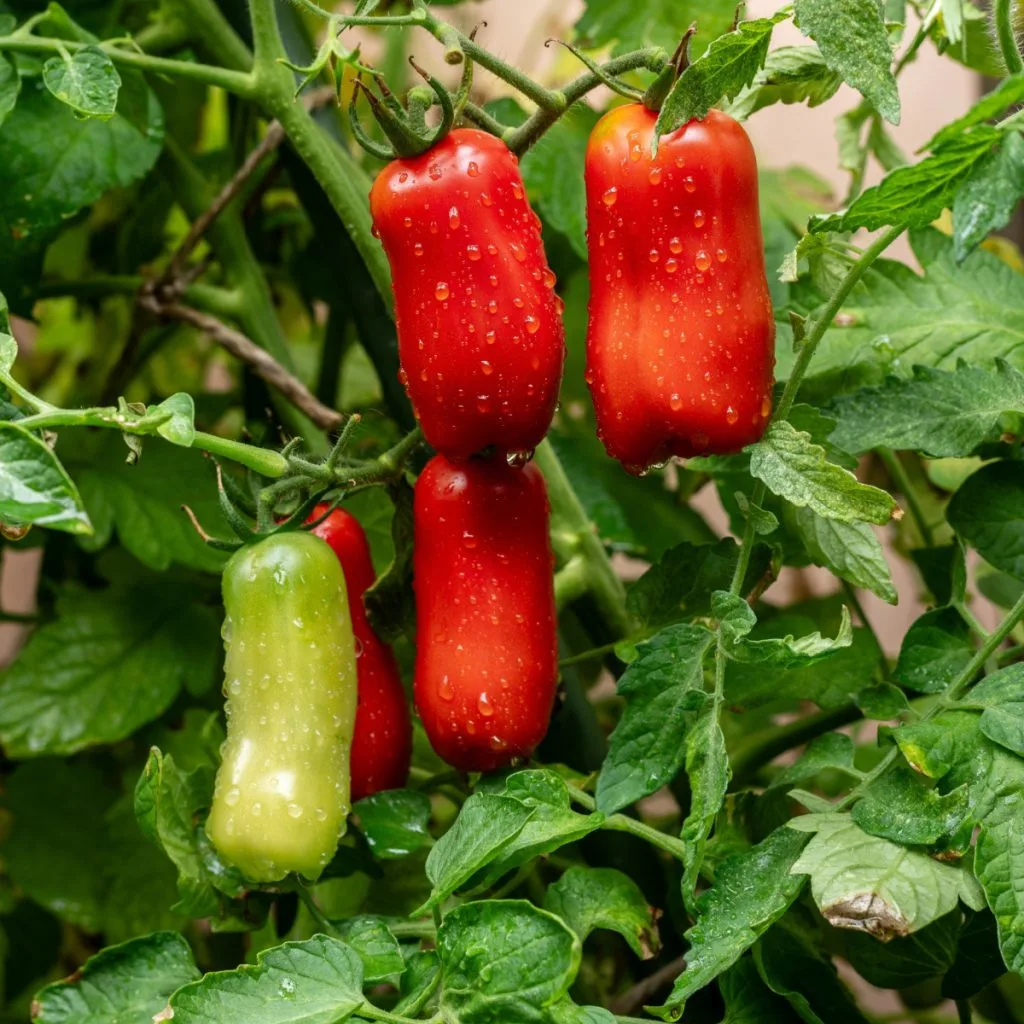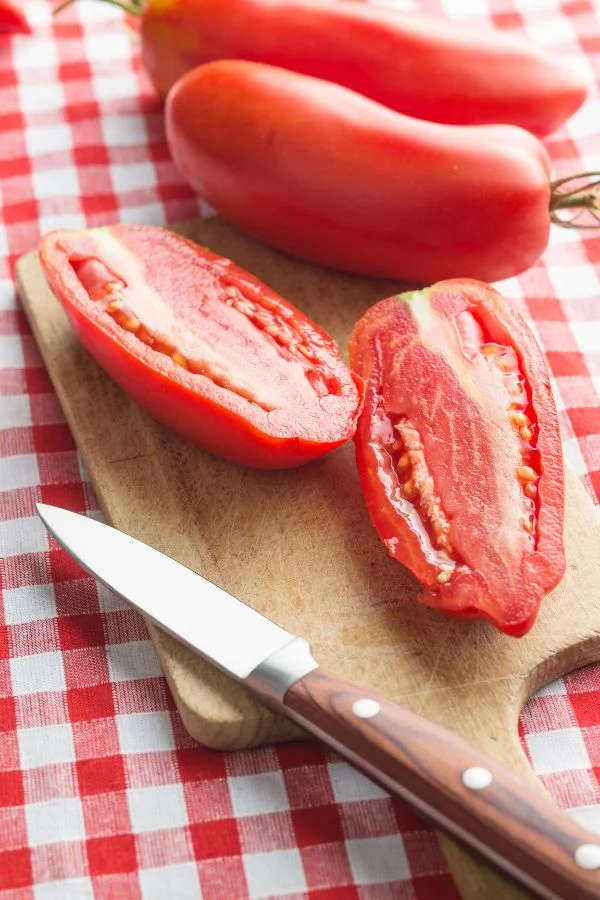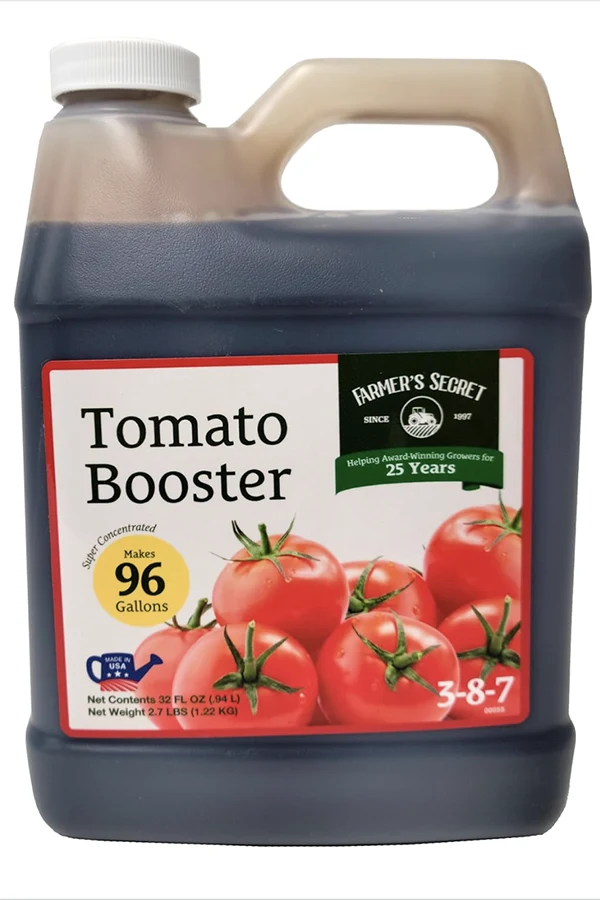If you are looking for the best salsa and pasta sauce tomato to grow this year- then you need to try your hand at planting San Marzano tomatoes!
When it comes to making rich and flavorful sauces, the San Marzano tomato is hard to beat. Renowned for its incredible taste and meaty texture, this tomato variety has earned a top spot as the go-to tomato for both cooks and gardeners alike.
The flavor of the San Marzano can be best described as slightly sweet with rich, hearty undertones. Because of its intense flavor and meaty interior, the tomato cooks down perfectly into a thicker sauce than most other tomato varieties will produce. (Check out this great recipe for your San Marzanos: How To Make Sun-Dried Tomatoes – Oven & Dehydrator Instructions)

Their elongated shape, thin skin, small seed core and exceptional balance of sweetness and acidity make them the ideal choice for home use. But beyond its incredible taste, what really makes the San Marzano stand out is how productive it can be. It produces a large amount of fruit on its vines, while usually only growing to a total height of three to four feet.
How To Grow San Marzano Tomato Plants
The Tomato Plant You Can Grow Almost Anywhere!
Because of its more compact growing style, the San Marzano is perfect for growing almost anywhere. It is great for traditional gardens and raised beds, but you can also grow it quite successfully in larger container gardens as well. It also requires far less support, staying upright with simple stakes or tomato cages with ease.
But perhaps best of all, this high producing plant also happens to be an indeterminate variety, so it will keep producing a large harvest of tomatoes right up until your first frost. Of heirloom paste tomatoes, it is still today considered to be the gold standard for making sauce.
Because San Marzano tomatoes have become quite popular, you can often find local nurseries and greenhouses carrying the tomato as a transplant in the spring – making it easier than ever to enjoy this great tomato variety!

What San Marzano Tomato Plants Need To Grow & Produce
San Marzano tomato plants thrive on what nearly all tomato plans do – good soil, plenty of sunlight, consistent watering and plenty of space to grow.
When planting, plant transplants deep into the soil. This will allow the plant to grow extensive roots – not only to help anchor it well from the large load of fruit – but also to help bring in as many nutrients from the soil as possible.
Dig planting holes six to eight inches deep and mix in plenty of compost to the hole. Adding in a quarter cup of worm castings, coffee grounds and ground egg shells to the planting hole can help provide plenty of power early on. See our article: The Best Way To Use Egg Shells To Help Your Tomato Plants – Protect & Power Tomatoes!
San Marzano tomatoes thrive on sunlight. With that in mind, choose a location that receives at least six to eight hours of direct sunlight daily. The more the better as sunlight helps fuel the plants growth and also its ability to ripen its fruit.
Although they only grow to three to four feet in height, the San Marzano is bushy. Allow two to three feet between plants to give them plenty of room to grow. This also allows for good air circulation, reducing the risk of disease and helping with pollination as well.

Mulching, Fertilizing & Watering San Marzano Tomato Plants
Once you have finished planting, mulch plants with a four to six inch layer of straw, shredded leaves or grass clippings. This aids in keeping competing weeds out and helps the soil conserve water for the plant’s roots.
San Marzano tomatoes need consistent and even watering throughout their growth cycle. On average, growing plants need 1 to 1.5 inches of rainfall each week. If that is not falling from the sky, then hand watering is a must. This is where mulch can be incredibly helpful in helping the soil from drying out too quickly.
When watering, water at the base of the plant. Always avoid overhead watering. Not only can it knock off blooms and forming fruit, it can also lead to mildew and other disease. Wet leaves often have trouble drying out, especially in humid conditions. The longer the leaves stay wet, the more likely issues will occur.
San Marzano’s require a fair amount of nutrients from the soil. Because of that, regular fertilizing can really help improve plant growth and yields. For best results, fertilize plants every 10 to 14 days with a liquid fertilizer.

Look for a fertilizer that has a lower nitrogen number and a higher phosphorous and potassium ratio. This will allow the plant to work harder on blooms and fruiting than just overall growth. Affiliate Link: Farmer’s Secret Tomato Booster Fertilizer (32oz) – Super Concentrated – 3:8:7
Supporting Your Plants
As San Marzano tomatoes mature, they produce heavy fruit clusters that can weigh down the branches. It is always best to put supports in place at the time of planting. This supports tomatoes early on – and helps prevent damage to the roots by driving them in later.
San Marzano tomatoes will benefit from light pruning to encourage airflow and reduce the risk of disease. A good rule of thumb is to prune the bottom 4-6” inches off the plant as it grows. This allows light and air to circulate throughout the plant more easily, helping with pollination and reducing the chance of disease.
San Marzano tomatoes are typically ready to harvest two to three months after transplanting. Look for deep red coloration, firm texture, and a slightly sweet aroma. Gently twist or cut the tomatoes from the vine to avoid damaging the plant.
You can also pick early and have the tomatoes ripen off the vine. Once the tomato has blushed or slightly turned pink, it will continue to ripen off the plant. This can be helpful when the plant has a large amount of fruit on all at once. Here is to growing San Marzano tomatoes in your backyard this year! If you are looking for more great tomato varieties to grow, see: Why You Need To Grow The Red Torch Tomato Plant Next Year!
I Grow Tomatoes
Follow Our Facebook Page For Even More Great Tomato Growing Tips! I Grow Tomatoes Facebook Page
I Grow Tomatoes is a website created for those who love all things about tomatoes – from planting and growing – to cooking and canning! We publish two articles every week, 52 weeks a year. Sign up today to follow via email! This article may contain affiliate links.
